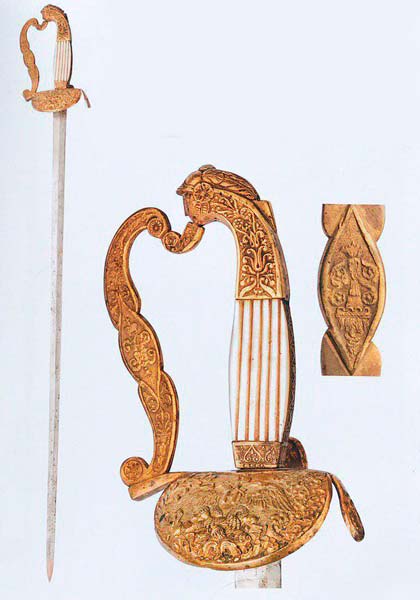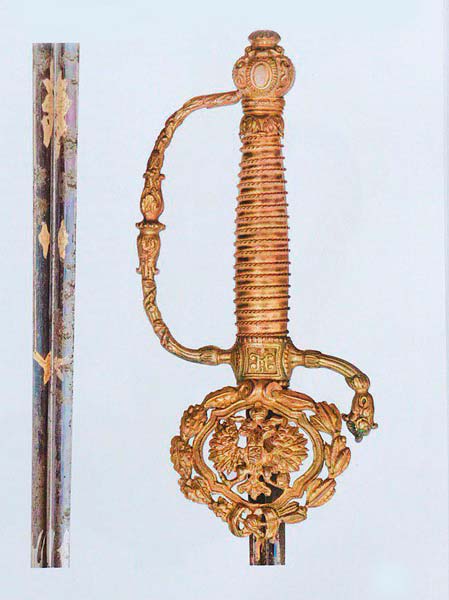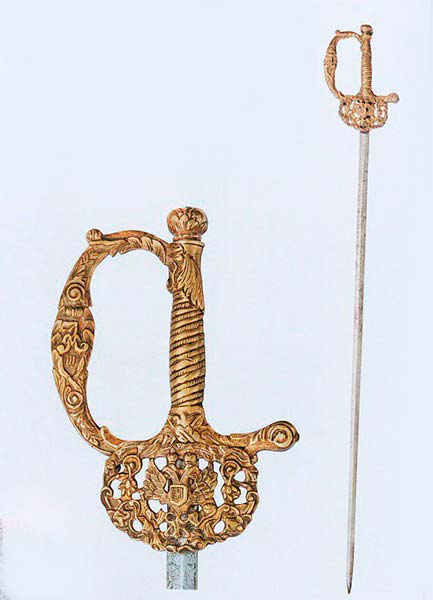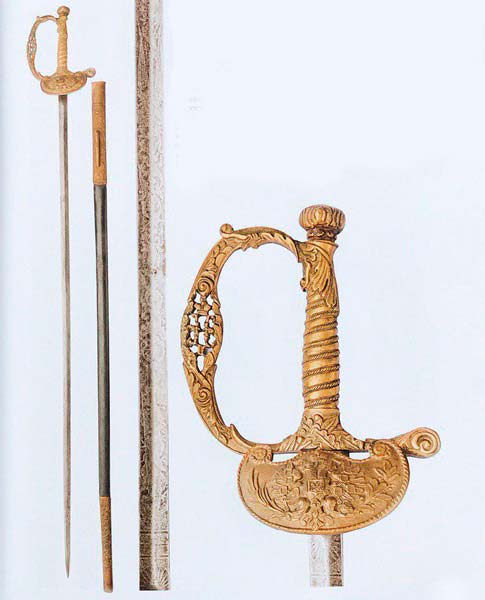The text on the site is translated into English, errors are possible. Sorry...
Smallsword russian imperial of civil servants of the 1855 model and its variations
On April 18, 1855, changes were approved in the uniform of the Civil Department. Their appearance was primarily caused by the replacement of tailcoat-type uniforms worn by Russian officials for more than half a century, the so-called “semi-caftans”, which had converging floors in front. In the same changes, not only was a single sword for officials mentioned for the first time, but there was also a direct indication that this swatch was introduced for the first time and differed from the previous ones.
Thus, in 1855, the civilian sword, thanks to a published sketch of the Ephesus, for the first time acquired an appearance that became a classic. For more than sixty years, until the end of the Russian Empire, it has hardly changed. Unfortunately, the author of the sketch is unknown, but its creation was clearly influenced by French models of civilian weapons.
The sword of the 1855 model had a bronze gilded ephesus, consisting of a handle with diagonal grooves intertwined with twisted wire, one protective bracket, a shield with the image of the Russian state emblem – a double-headed eagle with outstretched wings. The center of the guard bracket could have an additional decor in the form of an imperial monogram (emperors Alexander II, Alexander III, Nicholas II). Sword blades could be completely arbitrary, differing both in structure and in size and decorative elements. The most common are monocotyledonous nickel-plated blades of German companies “E. & F. Hoster »,« W. Clauberg ”,“ FW Holler ”and others, which often had etched ornaments and a relatively low cost. The most common among Russian companies in the production of sword blades were “Cabinets and Sons”, Zlatoust Arms Factory. The scabbards of civilian swords were most often made of leather, less often of wood, covered with leather. The metal device of the scabbard was made of gilded brass and consisted of a mouth with a peg for fastening in the blade of the purse and the tip.
On March 8, 1856, “Changes in the form of clothing for the ranks of the civil department and the rules of wearing this uniform” were introduced. Now the right to carry a sword arr. In 1855 it was finally assigned to the ranks of 1-10 ranks inclusive, including members of the State Council. Officials of the court stable department, as well as class and medical officials: the mining department, the department of railways and public buildings, police officials and others did not have the privilege of carrying a sword.
A new type of sword was also awarded to some court officials in 1855: “Swords for chief stablemen, chief huntsmen, stable masters and huntsmen are the same, and for other court officials of a new form, according to the highest approved model for civil service ranks.” The sword was relied on by court and civil officials in ceremonial, festive and ordinary uniforms, it was not relied on in everyday and road uniforms. Civilian weapons were removed during the worship of icons, the bride and groom during the wedding ceremony, during ballroom dancing. On May 11, 1898, a civilian sword was awarded to Foresters Corps officials.
Since 1904, almost all officials of the empire have received a civilian sword. It was one of the first to be assigned to railway workers. On August 24, 1904, Nicholas II approved the “Description and Rules of Wearing Uniforms for Civilian Officials of the Ministry of Railways”, according to which officials of class VI and above received a civilian sword to wear in formal or everyday uniform. At the same time, the sword (without a sling) could be worn by clerical officials, as well as clerical officials from the nobility or persons who do not have ranks, but hold class positions. The clerks did not rely on the sword.
In the same year, one after another, other departments and ministries receive a civilian sword:
April 1, 1903 – ranks of the General Directorate of Merchant Shipping and Ports (except port establishments, which was assigned a sea-style dagger)
March 18, 1904 – ranks of the Finnish Civil Service
May 17, 1904 – ranks of His Imperial Majesty’s Office and General Office Horse Breeding
August 24, 1904 – ranks of the Department of the Orthodox Denomination, the Imperial Philanthropic Society, the Department of State Control.
October 13, 1904 – ranks of the Ministry of Justice (clerical officials of noble origin, the right to carry a sword was also allowed, but without a sling), the Ministry of Education and the Ministry of Finance.
October 25, 1904 – ranks of the Office of the Special Committee of the Far East and the Office of the Committee of Ministers
November 16, 1904 ranks of the Ministry of Agriculture and State Property.
Thus, the civil sword of the 1855 model and the rules of its carrying were preserved until 1917.
It is possible to allocate 4 basic types of sword ephesus of a sample of 1855 and on their basis to construct classification of swords:
- Ephesus of 1855 with a shield depicting an eagle of the “French type” (version with outstretched wings). This type of shield is typical for the first years of production of the 1855 sword, but it is possible that it was produced for some time after 1857.
2. A variant of a sword with an imperial monogram on the hilt of the ephesus. There are openwork ephesus with the monograms of the emperors Alexander II (1855-1881), Alexander III (1881-1894, the most common type), Nicholas II (1894-1917). In general, ephesus of this type of brand did not have the manufacturer, the blades were very diverse.
3. The openwork version of the ephesus, presumably the design of the German company E. & F. Hoster in Solingen. It differs most from the design version: the brass handle, decorated with schematic images of French royal lines, the shield and the handle of the guard, are decorated with numerous curls. Brass parts do not have a mark.
4. A variant of the ephesus, almost completely corresponding to the sketch of 1855, but having the state emblem of the 1857 model. Swords of this type have hundreds of options of execution of a guard, however the main details of registration of an ephesus are observed.










